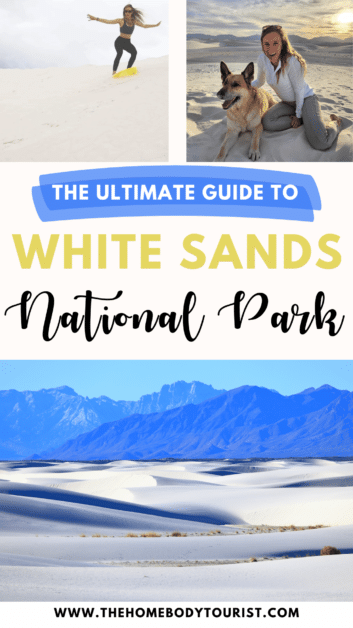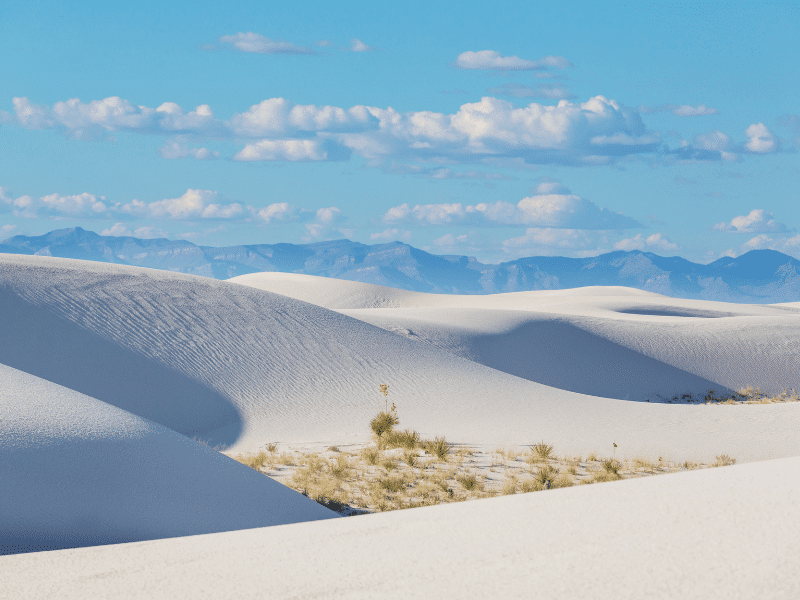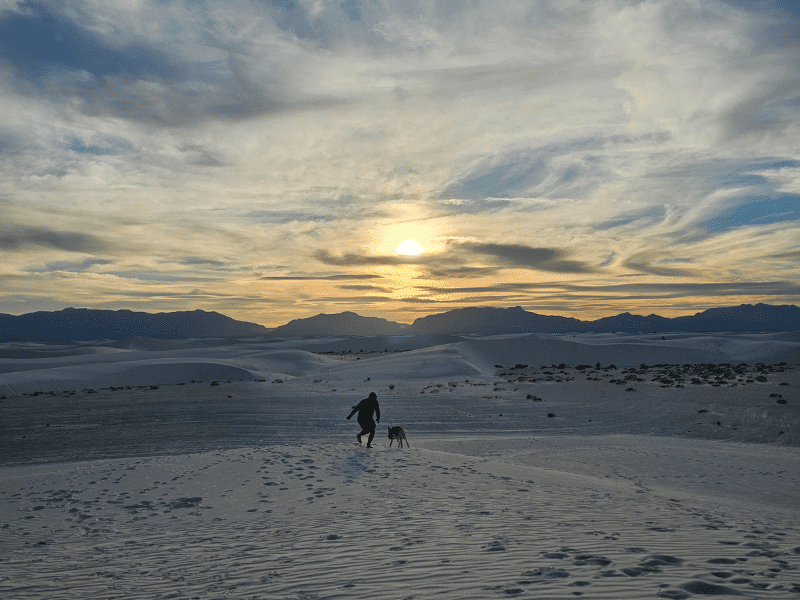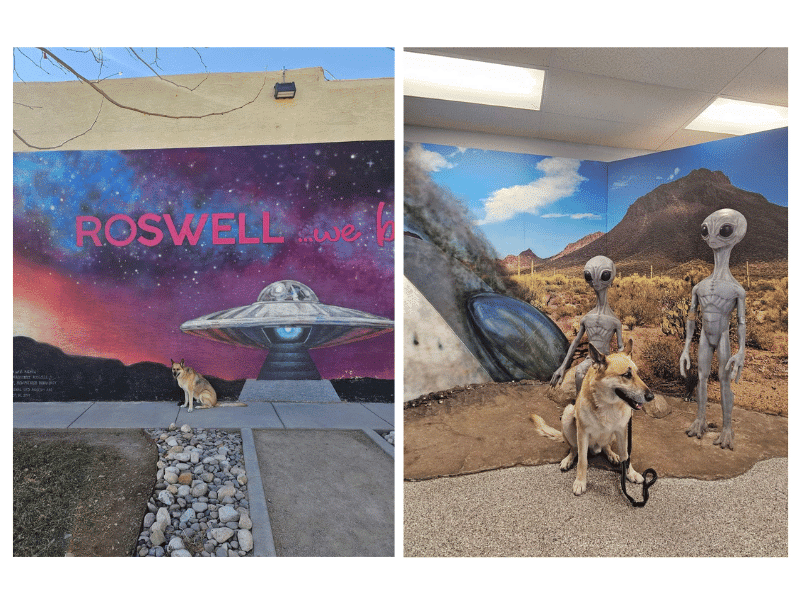Ultimate Guide to Visiting White Sands National Park
White Sands National Park is a stunning natural wonder located in southern New Mexico. It’s one of my most favorite places in the USA and one of the only that I have visited more than once.
Known for its vast gypsum sand dunes (and its dog-friendliness), this unique landscape offers a variety of activities and experiences for both two-legged and four-legged visitors. Whether you’re planning a day trip or an extended stay, this guide will provide everything you need to know before visiting White Sands National Park.

This post contains affiliate links to products. I may receive a commission for purchases made through these links at no extra cost to you. I only recommend products I truly love 🙂
Table of Contents
White Sands National Park Quick Facts!
White Sands National Park is the largest gypsum dune field in the world, covering 275 square miles of white, powdery sand. The park is known for its surreal landscape, which appears almost like a snow-covered desert (Thor, my dog, is 100 percent convinced it is snow). It’s a must-visit destination for nature lovers, photographers, and adventurers alike.
Here are some quick facts about the park!
| Location: | The park is located in the Tularosa Basin of southern New Mexico, approximately 16 miles southwest of Alamogordo. |
| Hours: | White Sands National Park is open year-round, from 7 am to sunset. Be sure to check out the website prior to your visit because it is occasionally closed for missile testing. |
| Fees: | The entrance fee for private vehicles is $25, valid for seven days. |
| Pets allowed? | Yes, pets are welcome! It’s one of the most pet-friendly National Parks I’ve ever been to! |
| Visitor Center | 9 AM – 5 PM The visitor center at White Sands offers exhibits, a gift shop, and restrooms. Rangers are available to answer questions and provide guidance on how to make the most of your visit. |
Best Time to Visit White Sands National Park
The best time to visit White Sands is during the cooler months, from October to April. Summer temperatures can soar above 100°F, making it less ideal for outdoor activities. Winter months offer chilly temperatures and fewer crowds, though nighttime can be especially cold.
I visited once during March and once during April and the weather was perfect for a day outdoors. Just be sure to pack layers as it can get windy and a bit chilly (especially if you are staying to watch the sunset).
Average Temperatures by Month
- January 57° / 22°
- February 63° / 26°
- March 71° / 32°
- April 79° / 40°
- May 88° / 49°
- June 97° / 59°
- July 97° / 64°
- August 94° / 62°
- September 89° / 55°
- October 79° / 41°
- November 66° / 29°
- December 57° / 22°
Getting to White Sands National Park:
It’s no secret that White Sands isn’t the easiest National Park to reach. However, if you find yourself in New Mexico, it’s 1,000 percent worth the detour.
The closest airport is in El Paso, Texas, about 85 miles away, making it a convenient starting point for travelers flying in. From El Paso, you can take U.S. Highway 54 north to Alamogordo, the nearest town to the park, then follow U.S. Route 70 west for about 15 miles to reach the entrance.
Other nearby airports:
- El Paso International Airport (ELP) – 85 miles
- Alamogordo-White Sands Regional Airport (ALM) – 15 miles
- Las Cruces International Airport (LRU) – 62 miles
- Roswell International Air Center (ROW) – 126 miles
- Albuquerque International Sunport (ABQ) – 220 miles
- Santa Fe Regional Airport (SAF) – 265 miles
Things to do at White Sands National Park

1. Take a hike
Several trails of varying difficulty levels are available, from short nature walks to longer backcountry hikes. The Alkali Flat Trail is a popular choice for those looking to experience the vastness of the dune field.
Don’t miss the opportunity to explore the Dune Life Nature Trail, a one-mile loop that provides insight into the plants and animals that call this unique environment home.
2. Join a guided tour/Ranger Program
White Sands National Park hosts nightly sunset strolls with a park ranger. You simply meet the group at the Sunset Stroll Parking lot and no reservations are needed. This guided stroll time differs depending on the time of the year.
There are also Lake Lucero and Full Moon guided hikes that are offered a few time each year. Be sure to check out the park’s calendar for all the details!
3. Go Sledding/Sandboarding

One of the most popular (and definitely most fun) activities at White Sands is sledding down the dunes. You can bring your own sled or rbuy one from the visitor center. When we visited, there were used and new sleds available that ranged from $17-$26. You could also return your sled at the end of your time for $5 back.
There’s also wax available to purchase that is supposed to make your sled glide better down the dunes.
Note: The gift shop is only open until 5pm so if you are arriving after this time, be sure to bring your own sled or sandboard.
4. Watch the Sunset

White Sands sunsets are completely out of this world and the main reason we went back for a second trip. Bring a blanket, layers, and some snack and hike out to find a cozy spot to watch the sun go down.
The park does close at sunset, so you will have to pack up and leave after. Backcountry camping is currently closed for the rehabilitation of campsites.
Know Before You Go
- Sun and Heat Safety: In the summer, temperatures can reach dangerous levels. It’s crucial to stay hydrated, seek shade, and avoid strenuous activity during the hottest part of the day. There is absolutely no shade here.
- Emergency Preparedness: Cell phone reception is limited in the park, so it’s wise to inform someone of your plans and expected return time. In case of an emergency, park rangers are trained to assist.
- Missile Testing: Be sure to check out the website prior to your visit because it is occasionally closed for missile testing.
- Driving Conditions: The roads leading to the park are well-maintained, but be cautious of occasional sand drifts on the roadways.
Accessibility of White Sands

Wheelchair Accessibility
The visitor center and some trails are wheelchair accessible. The Interdune Boardwalk offers an elevated view of the dunes and is fully accessible.
Parking and RV Accommodations
Ample parking is available, including spaces for RVs and larger vehicles. However, there are no hookups or campsites within the park.
Where to Stay near White Sands National Park
Camping Options
Backcountry camping is NOT currently allowed due to the rehabilitation of the campsites (as of October 2024). Check the website for updates.
Hotels near White Sands
For those who prefer more comfort, there are hotels and motels in nearby Alamogordo. Here are some of my recommendations as to where to stay near the park!
- Fairfield Inn & Suites Alamogordo: Located about 20 minutes from White Sands, this modern hotel offers comfortable rooms, free breakfast, a fitness center, and an outdoor pool.
- Hampton Inn Alamogordo: This popular hotel is also a short drive from the park and features clean, modern rooms, complimentary breakfast, and an indoor pool. It’s well-suited for families or couples.
- The Classic Desert Aire Hotel: A budget-friendly option in Alamogordo, the Classic Desert Aire Hotel provides basic rooms with free breakfast and a heated outdoor pool, perfect for a no-frills stay close to White Sands.
- Tavares Inn Bed & Breakfast: A cozy, boutique-style bed and breakfast located a bit further from the park (about 30 minutes), Tavares Inn offers personalized service, comfortable rooms, and a peaceful, home-like atmosphere.
- White Sands Motel: A simple, budget motel located in Alamogordo, this family-owned spot offers clean and affordable rooms, making it a good choice for travelers seeking a more local, no-fuss experience.
Campsites near White Sands National Park
- Oliver Lee Memorial State Park: About 30 minutes from White Sands, this scenic state park offers campsites with breathtaking views of the Sacramento Mountains. Facilities include restrooms, showers, and water hookups. It’s a great spot for RV or tent camping with easy access to hiking trails.
- Boot Hill RV Resort: Located near Alamogordo, this RV campground offers full hookups, free Wi-Fi, and clean facilities. It’s a popular spot for RV travelers looking for a convenient base camp near White Sands.
- Bluff Springs Campground: Nestled in the Lincoln National Forest, this free, primitive camping site is about 45 minutes from White Sands. It offers a more rugged camping experience with limited facilities but stunning natural surroundings and a peaceful atmosphere.
Other Things to do near White Sands National Park

- New Mexico Museum of Space History: A museum dedicated to space exploration history, perfect for science enthusiasts.
- Alameda Park Zoo: One of the oldest zoos in the Southwest with a variety of animal exhibits.
- Heart of the Desert Pistachios & Wine: A family-owned farm offering tours, wine tastings, and pistachio treats.
- Three Rivers Petroglyph Site: Explore over 21,000 petroglyphs created by the Jornada Mogollon people, just an hour’s drive from White Sands
- Cloudcroft, NM: Located in the Lincoln National Forest, this charming mountain town offers hiking, scenic drives, and winter activities like skiing.
- Trestle Recreation Area: Hike or bike through historic railroad trestles surrounded by forest views.
- Organ Mountains-Desert Peaks National Monument: About an hour and a half from White Sands, this area offers breathtaking landscapes, hiking trails, and opportunities for wildlife watching.
- Old Mesilla Village: A historic town with charming shops, restaurants, and the famous Mesilla Plaza.
- Valley of Fires Recreation Area: Walk along the lava fields of an ancient volcanic site for unique desert scenery.
- Tularosa Basin Museum of History: Discover local history, and artifacts, and learn more about the region’s cultural significance.
Check out all the best things to do in Alamogordo + a perfect weekend itinerary!
Is White Sands National Park Worth a Visit?!
White Sands National Park is a destination unlike any other. With its unique landscape, rich history, and variety of activities, it is 1000 percent worth a visit. Whether you’re seeking adventure, relaxation, or simply a new experience, a visit to White Sands is sure to be unforgettable (+ your adventure-loving pup will surely thank you!)
Be the first to comment